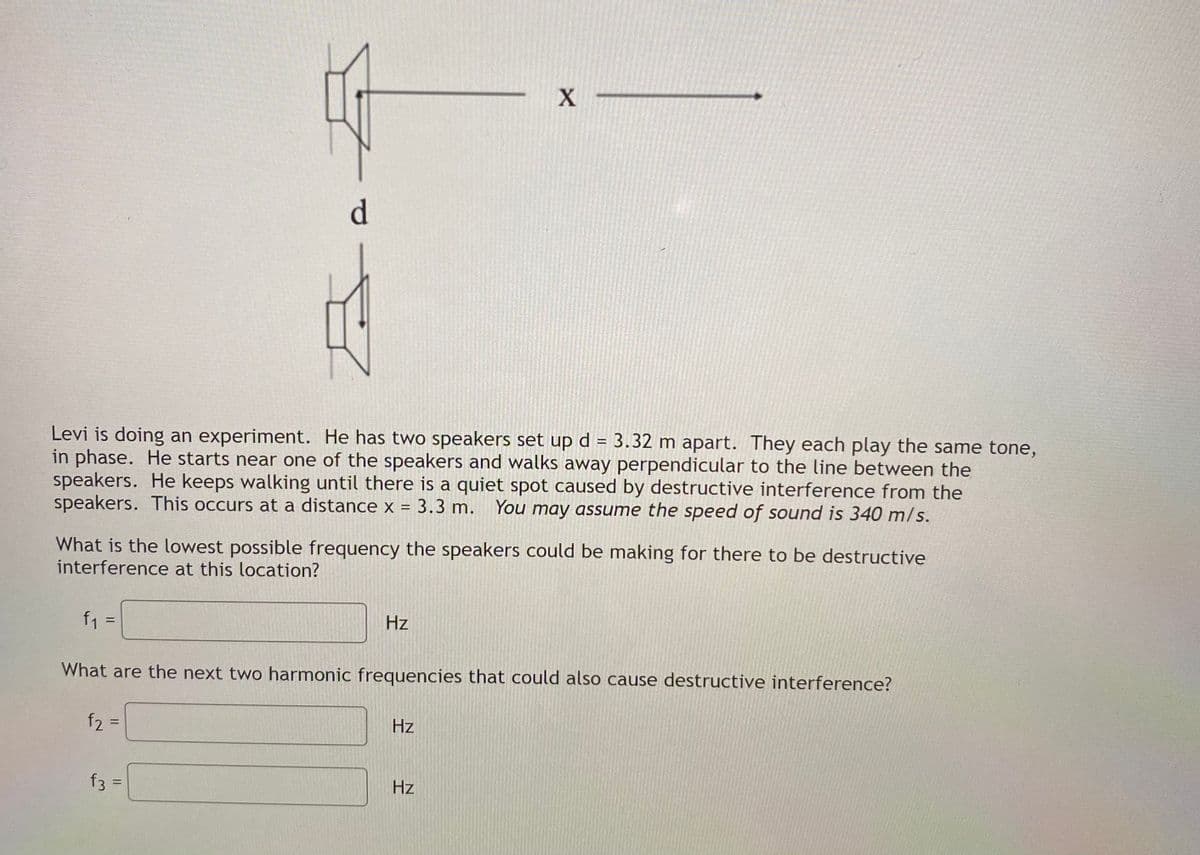X d. Levi is doing an experiment. He has two speakers set up d = 3.32 m apart. They each play the same tone, in phase. He starts near one of the speakers and walks away perpendicular to the line between the speakers. He keeps walking until there is a quiet spot caused by destructive interference from the speakers. This occurs at a distance x = 3.3 m. You may assume the speed of sound is 340 m/s. What is the lowest possible frequency the speakers could be making for there to be destructive interference at this location? f = Hz What are the next two harmonic frequencies that could also cause destructive interference? f2 = Hz f3 = Hz
X d. Levi is doing an experiment. He has two speakers set up d = 3.32 m apart. They each play the same tone, in phase. He starts near one of the speakers and walks away perpendicular to the line between the speakers. He keeps walking until there is a quiet spot caused by destructive interference from the speakers. This occurs at a distance x = 3.3 m. You may assume the speed of sound is 340 m/s. What is the lowest possible frequency the speakers could be making for there to be destructive interference at this location? f = Hz What are the next two harmonic frequencies that could also cause destructive interference? f2 = Hz f3 = Hz
Principles of Physics: A Calculus-Based Text
5th Edition
ISBN:9781133104261
Author:Raymond A. Serway, John W. Jewett
Publisher:Raymond A. Serway, John W. Jewett
Chapter14: Superposition And Standing Waves
Section: Chapter Questions
Problem 10P
Related questions
Concept explainers
Interference of sound
Seiche
A seiche is an oscillating standing wave in a body of water. The term seiche pronounced saysh) can be understood by the sloshing of water back and forth in a swimming pool. The same phenomenon happens on a much larger scale in vast bodies of water including bays and lakes. A seizure can happen in any enclosed or semi-enclosed body of water.
Question

Transcribed Image Text:d.
Levi is doing an experiment. He has two speakers set up d = 3.32 m apart. They each play the same tone,
in phase. He starts near one of the speakers and walks away perpendicular to the line between the
speakers. He keeps walking until there is a quiet spot caused by destructive interference from the
speakers. This occurs at a distance x = 3.3 m. You may assume the speed of sound is 340 m/s.
What is the lowest possible frequency the speakers could be making for there to be destructive
interference at this location?
f1 =
Hz
What are the next two harmonic frequencies that could also cause destructive interference?
Hz
%3D
f3 =
Hz
Expert Solution
This question has been solved!
Explore an expertly crafted, step-by-step solution for a thorough understanding of key concepts.
This is a popular solution!
Trending now
This is a popular solution!
Step by step
Solved in 6 steps

Knowledge Booster
Learn more about
Need a deep-dive on the concept behind this application? Look no further. Learn more about this topic, physics and related others by exploring similar questions and additional content below.Recommended textbooks for you

Principles of Physics: A Calculus-Based Text
Physics
ISBN:
9781133104261
Author:
Raymond A. Serway, John W. Jewett
Publisher:
Cengage Learning

Physics for Scientists and Engineers: Foundations…
Physics
ISBN:
9781133939146
Author:
Katz, Debora M.
Publisher:
Cengage Learning

Physics for Scientists and Engineers, Technology …
Physics
ISBN:
9781305116399
Author:
Raymond A. Serway, John W. Jewett
Publisher:
Cengage Learning

Principles of Physics: A Calculus-Based Text
Physics
ISBN:
9781133104261
Author:
Raymond A. Serway, John W. Jewett
Publisher:
Cengage Learning

Physics for Scientists and Engineers: Foundations…
Physics
ISBN:
9781133939146
Author:
Katz, Debora M.
Publisher:
Cengage Learning

Physics for Scientists and Engineers, Technology …
Physics
ISBN:
9781305116399
Author:
Raymond A. Serway, John W. Jewett
Publisher:
Cengage Learning

University Physics Volume 1
Physics
ISBN:
9781938168277
Author:
William Moebs, Samuel J. Ling, Jeff Sanny
Publisher:
OpenStax - Rice University

Physics for Scientists and Engineers with Modern …
Physics
ISBN:
9781337553292
Author:
Raymond A. Serway, John W. Jewett
Publisher:
Cengage Learning

Physics for Scientists and Engineers
Physics
ISBN:
9781337553278
Author:
Raymond A. Serway, John W. Jewett
Publisher:
Cengage Learning